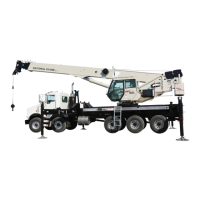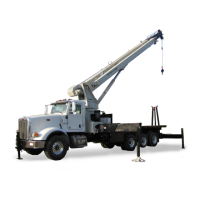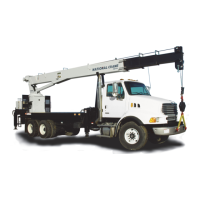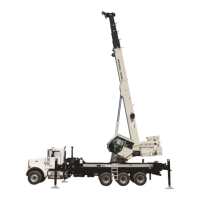SAFETY PRECAUTIONS - CRANE NBT40-1 SERIES OPERATOR MANUAL
2-26
3-29-2018 Control # 610-00
• The equipment is level within one percent of level grade
and located on a firm footing. Equipment with outriggers
shall have them all deployed following manufacturer's
specifications.
• The equipment Operators Manual and other operating
manuals are at the operator’s station and readily
accessible to the operator.
• The platform meets the requirements as prescribed by
applicable standards and regulations.
• For rope suspended platforms:
- The equipment is equipped with a hook that can be
closed and locked, eliminating the throat opening.
- The equipment is equipped with a functional Anti-
Two-Block Device.
- The platform is properly attached and secured to the
load hook.
• For boom mounted platforms:
- On equipment equipped with a boom mounted
personnel platform, use only a platform approved by
National Crane.
- The platform is properly attached and secure.
To avoid death or serious injury:
• NEVER use this equipment for bungee jumping or any
form of amusement or sport.
• NEVER handle personnel on the loadline unless the
requirements of applicable national, state and local
regulations and safety codes are met.
• NEVER permit anyone to ride loads, hooks, slings or
other rigging for any reason.
• NEVER get on or off a moving equipment.
• NEVER allow anyone other than the operator to be on
this equipment while the machine is operating or
traveling.
The following standards and regulations regarding personnel
handling are available by mail at the following addresses:
• ASME (formerly ANSI) B30 Series American National
Safety Standards For Cableways, Cranes, Derricks,
Hoists, Hooks, Jacks, and Slings; ASME B30.5, Mobile
And Locomotive Cranes, and ASME B30.23, Personnel
Lifting Systems, are available by mail from the ASME, 22
Law Drive, Fairfield, New Jersey, 0700-2900
• US DOL/OSHA Rules and Regulations are available by
mail from the Superintendent of Documents, PO Box
371954, Pittsburgh, PA, 15250-7954.
ENVIRONMENTAL PROTECTION
Dispose of waste properly! Improperly disposing of waste
can threaten the environment.
Potentially harmful waste used in National Crane equipment
includes — but is not limited to — oil, fuel, grease, coolant,
air conditioning refrigerant, filters, batteries, and cloths which
have come into contact with these environmentally harmful
substances.
Handle and dispose of waste according to local, state, and
federal environmental regulations.
When filling and draining equipment components, observe
the following:
• Do not pour waste fluids onto the ground, down any
drain, or into any source of water.
• Always drain waste fluids into leak proof containers that
are clearly marked with what they contain.
• Always fill or add fluids with a funnel or a filling pump.
• Immediately clean up any spills.
MAINTENANCE
The equipment must be inspected prior to use on each work
shift. The owner, user, and operator must ensure that routine
maintenance and lubrication are being dutifully performed.
Never operate a damaged or poorly maintained equipment.
National Crane continues to recommend that equipment be
properly maintained, regularly inspected and repaired as
necessary. National Crane reminds equipment owners to
ensure that all safety decals are in place and legible. Refer to
the Appendix A, of this Manual for the locations of safety
decals.
National Crane continues to urge equipment owners to
upgrade their equipment with rated capacity limiter and
control lever lockout systems for all lifting operations.
Shut down the equipment while making repairs or
adjustments.
Always perform a function check after repairs have been
made to ensure proper operation. Load tests should be
performed when structural or lifting members are involved.
Follow all applicable safety precautions in this manual when
performing equipment maintenance as well as equipment
operations.
Keep the equipment free of mud, dirt, and grease at all times.
Dirty equipment introduces hazards, wears-out faster, and
makes proper maintenance difficult. Cleaning solutions used
should be non-flammable, non-toxic and appropriate for the
job.
Routine maintenance and inspection of this equipment must
be performed by a qualified person(s) according to the

